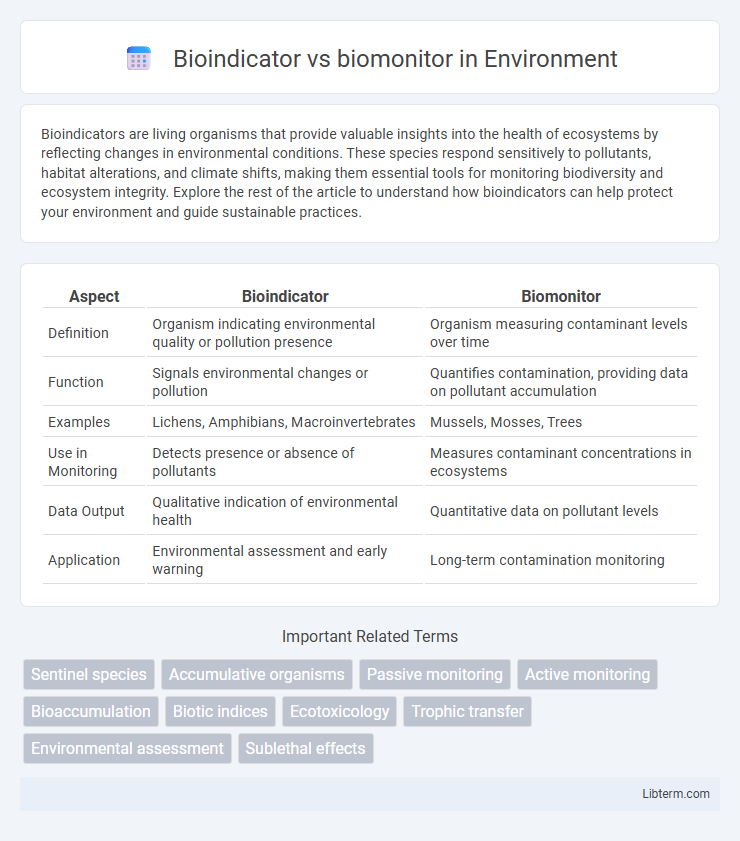Bioindicators are living organisms that provide valuable insights into the health of ecosystems by reflecting changes in environmental conditions. These species respond sensitively to pollutants, habitat alterations, and climate shifts, making them essential tools for monitoring biodiversity and ecosystem integrity. Explore the rest of the article to understand how bioindicators can help protect your environment and guide sustainable practices.
Table of Comparison
| Aspect | Bioindicator | Biomonitor |
|---|---|---|
| Definition | Organism indicating environmental quality or pollution presence | Organism measuring contaminant levels over time |
| Function | Signals environmental changes or pollution | Quantifies contamination, providing data on pollutant accumulation |
| Examples | Lichens, Amphibians, Macroinvertebrates | Mussels, Mosses, Trees |
| Use in Monitoring | Detects presence or absence of pollutants | Measures contaminant concentrations in ecosystems |
| Data Output | Qualitative indication of environmental health | Quantitative data on pollutant levels |
| Application | Environmental assessment and early warning | Long-term contamination monitoring |
Introduction to Bioindicators and Biomonitors
Bioindicators are species or biological responses used to assess environmental conditions, reflecting ecosystem health through the presence, absence, or abundance of organisms such as lichens or aquatic invertebrates. Biomonitors actively collect and measure specific pollutants or contaminants in the environment, often using organisms like mosses or bivalves to quantify pollutant accumulation over time. Both bioindicators and biomonitors provide critical data for ecological assessment, with bioindicators highlighting biological effects and biomonitors tracking contaminant levels directly.
Defining Bioindicators: Key Concepts
Bioindicators are species or biological parameters used to assess environmental conditions, reflecting changes and impacts in ecosystems. They provide measurable responses to pollutants, habitat alterations, or climate variations, serving as natural gauges of ecosystem health. Key concepts include specificity to stressors, sensitivity to changes, and reproducibility of biological responses for accurate environmental monitoring.
What Are Biomonitors? Meaning and Scope
Biomonitors are living organisms used to assess environmental conditions and detect changes, particularly in air, water, and soil quality. They provide real-time, cost-effective data on pollution levels and ecosystem health by accumulating contaminants or exhibiting physiological responses to stressors. Their scope includes tracking heavy metals, organic pollutants, and radiation, enabling early warning systems for environmental management and conservation efforts.
Core Differences Between Bioindicators and Biomonitors
Bioindicators are species or biological responses used to assess the health of an environment by signaling changes in ecosystem conditions, while biomonitors actively collect and measure specific contaminants or pollutants in the environment. Bioindicators typically reflect the cumulative impact of various stressors through changes in their behavior, physiology, or population dynamics, whereas biomonitors provide quantitative data on pollutant levels, such as heavy metals or toxic chemicals. The core difference lies in the passive role of bioindicators as natural sentinels compared to the active role of biomonitors in environmental sampling and analysis.
Types of Organisms Used in Bioindication vs Biomonitoring
Bioindicators typically involve specific organisms such as lichens, mosses, and certain insects that respond predictably to environmental changes, signaling pollution or habitat alterations. Biomonitoring employs a broader range of organisms, including fish, amphibians, and microorganisms, to continuously assess ecosystem health and contaminant levels over time. The choice of organisms in bioindication emphasizes sensitivity to particular stressors, while biomonitoring prioritizes species that provide quantitative data on environmental trends.
Methodologies: Bioindicator vs Biomonitor Approaches
Bioindicator methodologies involve using specific organisms or communities to assess environmental quality by detecting changes in their presence, abundance, or behavior, providing indirect information about ecosystem health. Biomonitor approaches employ continuous or periodic measurement of physical, chemical, or biological parameters within organisms or ecosystems, often involving direct sampling and analytical techniques to quantify pollutant levels or environmental stressors. Both methodologies integrate field surveys, laboratory analyses, and statistical modeling to interpret biological responses and enhance environmental monitoring accuracy.
Pros and Cons of Bioindicators
Bioindicators provide a cost-effective, easy-to-use means of detecting environmental changes by reflecting ecosystem health through species responses, but their sensitivity to multiple stressors can complicate data interpretation. They offer early warning signs of pollution and habitat degradation with minimal technological requirements, yet variability in species responses and ecological factors may limit their accuracy and specificity. Unlike biomonitors, which actively measure pollutant levels, bioindicators primarily signal biological effects, making them less precise for quantifying contaminant concentrations.
Advantages and Limitations of Biomonitors
Biomonitors offer real-time, cost-effective assessment of environmental pollution by directly reflecting biological exposure to contaminants, allowing for site-specific monitoring of air, water, and soil quality. Their limitations include potential variability due to biological factors such as species sensitivity, seasonal changes, and environmental conditions, which can complicate data interpretation. Unlike bioindicators that provide qualitative presence/absence data, biomonitors deliver quantitative insights but require calibration and validation for accurate environmental risk assessment.
Applications in Environmental Science and Ecological Assessment
Bioindicators serve as living organisms that reveal the quality of the environment by displaying physiological or population changes in response to pollutants, making them essential for assessing air and water contamination levels. Biomonitoring employs bioindicator data systematically over time to track trends in ecosystem health, guiding regulatory decisions and conservation efforts. These applications enable early detection of ecological disturbances and support sustainable management of natural resources by integrating biological responses with chemical and physical environmental data.
Choosing Between Bioindicator and Biomonitor: Factors to Consider
Choosing between a bioindicator and a biomonitor depends on the specific environmental parameters and monitoring goals. Bioindicators provide qualitative data reflecting ecosystem health through species presence and behavior, while biomonitors offer quantitative information by measuring contaminant accumulation in organisms. Understanding the pollutant type, required data precision, and temporal monitoring scope is essential for effective environmental assessment and decision-making.
Bioindicator Infographic

 libterm.com
libterm.com